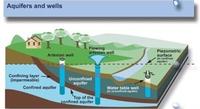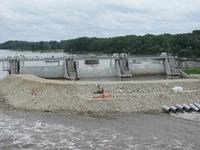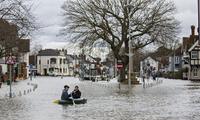-
Groundwater reservoirs are being depleted at an increasing rate

The rate at which the Earth’s groundwater reservoirs are being depleted is constantly increasing. Annual groundwater depletion during the first decade of this century was twice as high as it was between 1960 and 2000. India, the USA, Iran, Saudi Arabia, and China are the countries with the highest rates of groundwater depletion. About 15 percent of global groundwater consumption is not sustainable, meaning that it comes from non-renewable groundwater resources. The increased use of groundwater for irrigation also results in a rise in sea levels, with roughly one tenth of the total sea level rise during the period from 2000 to 2009 due to groundwater depletion.
-
-
Japan exceedingly vulnerable to sea level rise
Scientists say that Japan might be one of the most at-risk nations when it comes to the consequences of sea-level rise.Japan has a coastline 30,000 km long, and much of it in largely low-elevation regions. Additionally, about 80 percent of the country’s industry and population are located in these zones.
-
-
Debate in Texas over fossil fuel-based economic growth
Texas officials tout the state’s economic growth, which is due in part to the state’s energy sector. That same energy sector puts Texas’ economy at risk in decades to come, with scientists saying that this economic growth comes at a high cost.State climatologist John Nielsen-Gammon, who was appointed by then-Governor George W. Bush, notes that the state is projected to be several degrees warmer and experience longer and more severe droughts. The see along portions of the state’s 367-mile Gulf Coast has already risen up to one foot in the past century.
-
-
Mapping Florida sinkholes
Sinkholes are common in Florida because of porous rock underground, such as limestone, which holds water. Over time, acid in the water dissolves the rock, creating a void. The Florida Geological Surveyand Florida Department of Emergency Managementare making progress on creating a statewide map showing where sinkholes are most likely to form. Florida received more than $1 million in federal funding last year to conduct a three-year study which would eventually help emergency planners predict where sinkholes are likely to develop, especially after large rainstorms.
-
-
New materials, designs needed to fortify infrastructure against extreme weather
As cities prepare for the effects of climate change, higher temperatures for longer periods of time and a dramatic change in humidity and rainfall pose the highest risk to public infrastructure, scientists say. Buildings, roads, and bridges which were built for one set of climate conditions will have to function in another. Researchers say that analysis of changing conditions in Alaska, for example, shows that in thirty or forty years the state would have to rebuild roads every eighteen months unless new designs and materials were adopted.
-
-
Silicon Valley braces for floods, storm surges caused by sea level rise
A new analysis found that $36.5 billion in property and at least 145,000 California residents could be directly affected in the next thirty years from flooding caused by sea level rise. San Mateo County, home to major corporations including Facebook, Oracle, and Genentechin Palo Alto, and the low-income population of East Palo Alto, would be the most affected.
-
-
Earthquake researchers get online primer for simulation method
Researchers now have access to expert instruction for an emerging simulation method to study seismic effects on structures and to design buildings that better withstand strong earthquakes. The National Science Foundation’s (NSF) George E. Brown Jr. Network for Earthquake Engineering Simulation (NEES) is providing a primer on its NEEShub. he primer explains how to use hybrid simulations, methods that are helping researchers study the effects of earthquakes on buildings and other structures.
-
-
Design standards for dams are effective for earthquakes: study
There has long been a concern among civil engineers that dams could fail days or weeks after an earthquake, even if no immediate evidence of a problem surfaced. Their concern has focused on possible cracks at the interface between the concrete section of a dam and the soil embankments at the dam’s sides, and on how the soil filters nestled amidst the embankments would fare. Soil filters consist of coarser grain soils than the soil used in the dam’s impervious core, and their purpose in the event of a crack in the soil, is to prevent the finer core soil particles from rapidly eroding and flushing through the filter. Since soil filters were instituted, their design standards have been based on experimental studies without detailed and validated computer modeling of the soil grains — until now.
-
-
Assessing the damage of runaway barges at the Illinois River lock and dam

It takes a synchronized lock and dam system — operating like a motorized flight of stairs on the Illinois River, using gravity to move the water — to maintain a minimum depth for boat traffic. A disastrous domino effect occurred on 19 April 2013, when heavy rain and runoff, strong winds, and river currents resulted in seven unmoored barges crashing into the dam at Marseilles, Illinois. Researchers say that the system of locks and dams on the Illinois River is vulnerable to changing climate and weather extremes. These more frequent and unpredictable conditions can cause shipping accidents, damage to lock and dam systems, streambank erosion, shipping accidents, and local flooding.
-
-
Seattle builds resiliency in the face of changing climate
The federal government’s National Climate Assessment, released in May, detailed the region-by-region effects which includes water shortages, sea-level rise, and more frequent wildfires. Most American cities fall short on climate change preparation when compared to several major cities around the world. A survey conducted by MIT reported that globally, “the U.S. has the lowest percentage of cities engaged in (climate change) assessments and planning.” Seattle has decided it needs to act, and act now, to make itself more resilient in the face of a changing climate.
-
-
Microgrids offer cities resiliency, reliability, accessibility
A majority of the world’s population now lives in cities, which consume 75 percent of the world’s resources and emit most of its greenhouse gases. The United Nations estimates that by 2050, an additional three billion people will move into these dense, resource-intense urban environments. The focus in cities like New York or New Orleans is on building infrastructure to make cities more resilient when faced with extreme weather or natural disasters — by providing backup power during outages, as well as helping to ease systems back online as outages end. Microgrid researchers are taking up this challenge by developing an energy solution with the potential to strengthen all three critical factors of energy in a livable city: resiliency, reliability and accessibility.
-
-
“Smart” rocks detect bridge damage
It is hard to gauge how structurally sound a bridge is when its foundation is buried in a riverbed deep below the water’s surface. New “smart” rocks which are being developed by researchers will give engineers an accurate, easy and cost-effective tool to monitor a bridge’s foundation, in real time. The leading cause of bridge collapse in the United States is scour, an erosion process where water flow carries away river bed deposits and creates scour holes around the bridge pier or abutment. Smart rocks placed at the base of bridge foundations are designed to roll to the deepest point of a scour hole and act as field agents to relay scour depths.
-
-
DHS top priorities: addressing terrorism, cyberthreats, and extreme weather risks
In its second quadrennial review, DHS outlined the department’s efforts to enhance the five homeland security objectives detailed in the first review, issued in 2010. Combating terrorism remains DHS’s primary mission, but recent disasters, including the Deepwater Horizon oil spill in 2010, Hurricane Sandy in 2012, and domestic terrorism events such as the Boston Marathon bombings in 2013, along with cyberthreats against the nation’s infrastructure, have led the agency to adopt a risk-based approach to significant threats from both terrorism and natural disasters.
-
-
U.K. infrastructure facing tough challenges as extreme weather events multiply

The U.K. Institute of Civil Engineering’s (ICE) State of the Nation: Infrastructure 2014 report has highlighted the fact that more frequent extreme weather events will make it increasingly difficult to operate U.K. infrastructure networks in all conditions at the level of service U.K. residents have come to expect, and people’s expectations of availability will need to change. The report grades the U.K.’s Transport, Energy, Flood, Waste, and Water networks from A to E, suggesting more needed to be done if the United Kingdom is to have world class infrastructure.
-
-
Syrian Electronic Army’s attack on Reuters makes a mockery of cyber-security (again)

One big security issue that has arisen lately concerns control of news media. National boundaries have become blurred on the Internet, and the control any nation can have over information dissemination has been eroded — on news Web sites but especially on open platforms such as Twitter and Facebook. One lesson from all the attacks on open platforms is that a focus of any attempted hack will be a spear phishing e-mail. Tricking users into entering their details may be simple, but it can be very serious. For example the Reuters site, which was attacked by the Syrian Electronic Army (SEA), a pro-Assad group of “hacktivists,” integrates more than thirty third-party/advertising network agencies into its content. A breach on any of these could compromise the agency’s whole infrastructure.
-
- All
- Regional
- Water
- Biometrics
- Borders/Immig
- Business
- Cybersecurity
- Detection
- Disasters
- Government
- Infrastructure
- International
- Public health
- Public Safety
- Communication interoperabillity
- Emergency services
- Emergency medical services
- Fire
- First response
- IEDs
- Law Enforcement
- Law Enforcement Technology
- Military technology
- Nonlethal weapons
- Nuclear weapons
- Personal protection equipment
- Police
- Notification /alert systems
- Situational awareness
- Weapons systems
- Sci-Tech
- Sector Reports
- Surveillance
- Transportation
Advertising & Marketing: advertise@newswirepubs.com
Editorial: editor@newswirepubs.com
General: info@newswirepubs.com
2010-2011 © News Wire Publications, LLC News Wire Publications, LLC
220 Old Country Road | Suite 200 | Mineola | New York | 11501
Permissions and Policies
Editorial: editor@newswirepubs.com
General: info@newswirepubs.com
2010-2011 © News Wire Publications, LLC News Wire Publications, LLC
220 Old Country Road | Suite 200 | Mineola | New York | 11501
Permissions and Policies
